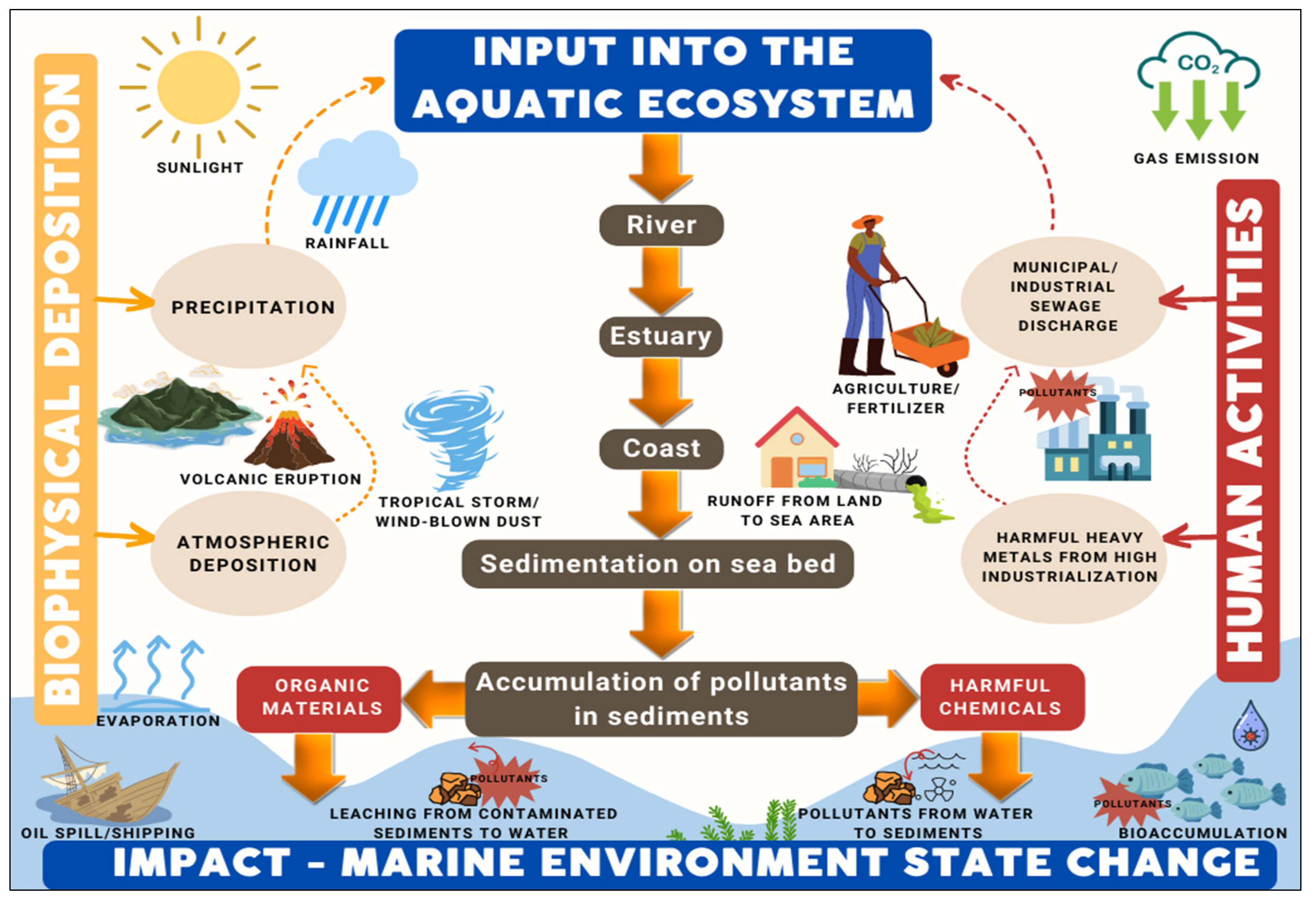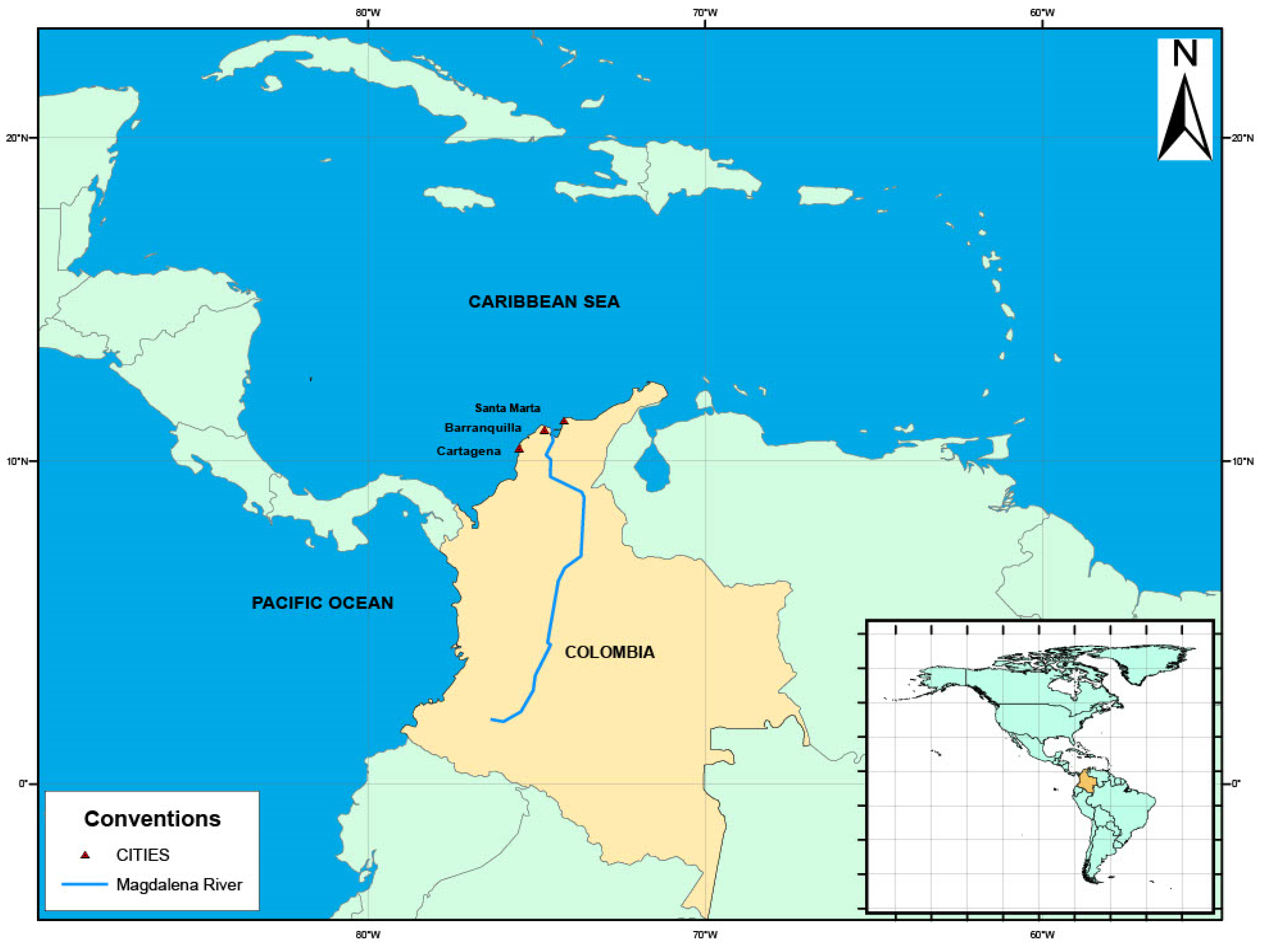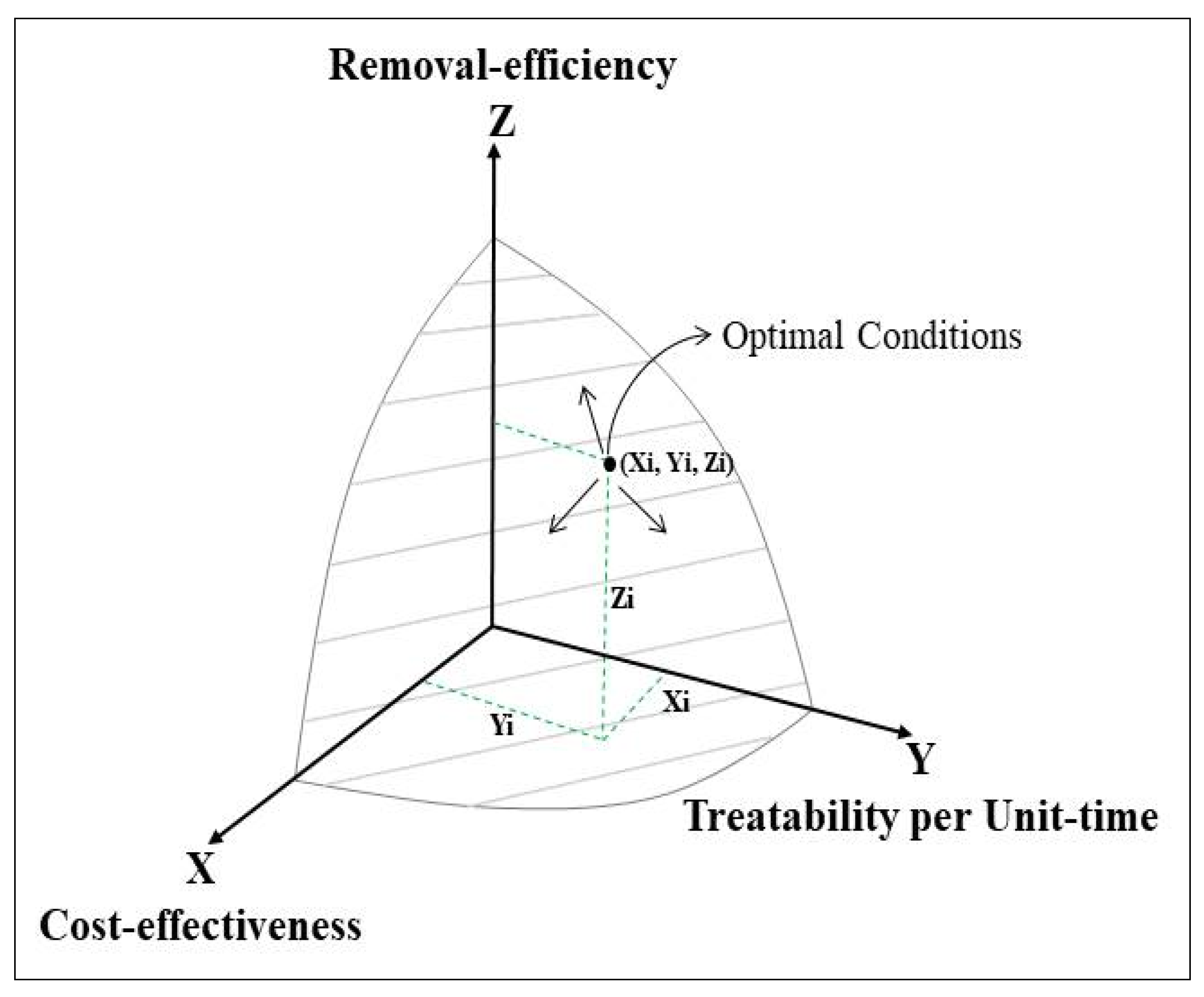How to Achieve Sustainably Beneficial Uses of Marine Sediments in Colombia?
Abstract
1. Introduction
2. Materials and Methods
2.1. Description of the Study Areas
2.2. Methodologies
3. Results
3.1. Marine Sediment Qualities of the Colombian Caribbean
3.2. Ex Situ Remediation Technologies
3.2.1. Physical Technologies
Particle Separation
Thermal Technologies
3.2.2. Chemical Technologies
Sediment Washing
Electrochemical Technologies
3.2.3. Physicochemical Technologies
3.2.4. Biological Technologies
4. Discussion

5. Conclusions
- (1)
- The advantages and disadvantages of remediation technologies should be compared and carefully considered before decision making. The favorable effect of combining two or more technologies to remediate MSs may enhance the results;
- (2)
- S/S combined with complex technologies were found to be efficient and cost-effective technologies to be adopted in Colombia. Remarkably, S/S may offer valuable end products obtained from treated sediments that may achieve environmental benefits and promote new circular economy strategies;
- (3)
- Policy makers may use the developed frameworks in this research as an integrated environmental tool to improve the selection of remediation alternatives. Significantly, the sustainable management of MSs will be achieved by optimizing their beneficial uses;
- (4)
- Beneficial uses of MSs directly or after treatment should be considered a priority and be promoted as much as possible, avoiding their common perception as waste. This new approach can generate positive environmental impacts and waste minimization;
- (5)
- New, simple, eco-friendly, and cost-effective technologies, along with integrated innovative management practices, are urgently required for the sustainable management of MSs.
Author Contributions
Funding
Institutional Review Board Statement
Informed Consent Statement
Data Availability Statement
Conflicts of Interest
References
- Mulligan, C.N.; Fukue, M.; Sato, Y. Sediments Contamination and Sustainable Remediation; IWA Pub: London, UK; CRC Press: Raton, FL, USA, 2010; ISBN 978-1-4200-6153-6. [Google Scholar]
- Edokpayi, J.; Odiyo, J.; Popoola, O.; Msagati, T. Assessment of Trace Metals Contamination of Surface Water and Sediment: A Case Study of Mvudi River, South Africa. Sustainability 2016, 8, 135. [Google Scholar] [CrossRef]
- IMO London Convention and Protocol: Guidance for the Development of Action Lists and Action Levels for Dredged Material. Available online: https://www.gc.noaa.gov/documents/gcil_imo_dmaction.pdf (accessed on 7 September 2022).
- Sustainable Management of the Beneficial Use of Sediments. Available online: http://www.dredging.org/media/ceda/org/documents/resources/cedaonline/2019-05-BUS-ip.pdf (accessed on 27 October 2022).
- Zheng, Z.-J.; Lin, M.-Y.; Chiueh, P.-T.; Lo, S.-L. Framework for Determining Optimal Strategy for Sustainable Remediation of Contaminated Sediment: A Case Study in Northern Taiwan. Sci. Total Environ. 2019, 654, 822–831. [Google Scholar] [CrossRef]
- Alvarez-Guerra, M.; Alvarez-Guerra, E.; Alonso-Santurde, R.; Andrés, A.; Coz, A.; Soto, J.; Gómez-Arozamena, J.; Viguri, J.R. Sustainable Management Options and Beneficial Uses for Contaminated Sediments and Dredged Material. Fresenius Environ. Bull. 2008, 17, 16. [Google Scholar]
- United Nations Environment Programme Sustainable Development Goals. Available online: https://www.unenvironment.org/explore-topics/oceans-seas/what-we-do/working-regional-seas/coastal-zone-management (accessed on 7 September 2022).
- Luo, T.; Han, T.; Madhusudhan, B.N.; Zhao, X.; Zou, D.; Song, Y. Strength and Deformation Behaviors of Methane Hydrate-Bearing Marine Sediments in the South China Sea during Depressurization. Energy Fuels 2021, 35, 14569–14579. [Google Scholar] [CrossRef]
- Geng, L.; Cai, J.; Lu, C.; Qin, X.; Qi, R.; Meng, F.; Xie, Y.; Sha, Z.; Wang, X.; Sun, C. Phase Equilibria of Natural Gas Hydrates in Bulk Brine and Marine Sediments from the South China Sea. J. Chem. Eng. Data 2021, 66, 4064–4074. [Google Scholar] [CrossRef]
- Fernandez-Maestre, R.; Johnson-Restrepo, B.; Olivero-Verbel, J. Heavy Metals in Sediments and Fish in the Caribbean Coast of Colombia: Assessing the Environmental Risk. Int. J. Environ. Res. 2018, 12, 289–301. [Google Scholar] [CrossRef]
- Caballero-Gallardo, K.; Olivero-Verbel, J.; Corada-Fernández, C.; Lara-Martín, P.A.; Juan-García, A. Emerging Contaminants and Priority Substances in Marine Sediments from Cartagena Bay and the Grand Marsh of Santa Marta (Ramsar Site), Colombia. Env. Monit Assess 2021, 193, 596. [Google Scholar] [CrossRef]
- Restrepo, J.C.; Schrottke, K.; Traini, C.; Ortíz, J.C.; Orejarena, A.; Otero, L.; Higgins, A.; Marriaga, L. Sediment Transport and Geomorphological Change in a High-Discharge Tropical Delta (Magdalena River, Colombia): Insights from a Period of Intense Change and Human Intervention (1990–2010). J. Coast. Res. 2016, 319, 575–589. [Google Scholar] [CrossRef]
- Tosic, M.; Restrepo, J.D.; Lonin, S.; Izquierdo, A.; Martins, F. Water and Sediment Quality in Cartagena Bay, Colombia: Seasonal Variability and Potential Impacts of Pollution. Estuar. Coast. Shelf Sci. 2019, 216, 187–203. [Google Scholar] [CrossRef]
- Duarte-Restrepo, E.; Noguera-Oviedo, K.; Butryn, D.; Wallace, J.S.; Aga, D.S.; Jaramillo-Colorado, B.E. Spatial Distribution of Pesticides, Organochlorine Compounds, PBDEs, and Metals in Surface Marine Sediments from Cartagena Bay, Colombia. Environ. Sci. Pollut. Res. 2021, 28, 14632–14653. [Google Scholar] [CrossRef]
- Neckel, A.; Osorio-Martinez, J.; Pinto, D.; Bodah, B.W.; Adelodun, B.; Silva, L.F.O. Hazardous Elements Present in Coal Nanoparticles in a Caribbean Port Region in Colombia. Sci. Total Environ. 2022, 838, 156363. [Google Scholar] [CrossRef] [PubMed]
- Torregroza-Espinosa, A.C.; Martínez-Mera, E.; Castañeda-Valbuena, D.; González-Márquez, L.C.; Torres-Bejarano, F. Contamination Level and Spatial Distribution of Heavy Metals in Water and Sediments of El Guájaro Reservoir, Colombia. Bull. Environ. Contam. Toxicol. 2018, 101, 61–67. [Google Scholar] [CrossRef] [PubMed]
- Zhang, Y.; Labianca, C.; Chen, L.; De Gisi, S.; Notarnicola, M.; Guo, B.; Sun, J.; Ding, S.; Wang, L. Sustainable Ex-Situ Remediation of Contaminated Sediment: A Review. Environ. Pollut. 2021, 287, 117333. [Google Scholar] [CrossRef]
- Peng, J.; Song, Y.; Yuan, P.; Cui, X.; Qiu, G. The Remediation of Heavy Metals Contaminated Sediment. J. Hazard. Mater. 2009, 161, 633–640. [Google Scholar] [CrossRef]
- Pal, D.; Hogland, W. An Overview and Assessment of the Existing Technological Options for Management and Resource Recovery from Beach Wrack and Dredged Sediments: An Environmental and Economic Perspective. J. Environ. Manag. 2022, 302, 113971. [Google Scholar] [CrossRef]
- Mulligan, C.N.; Yong, R.N.; Gibbs, B.F. An Evaluation of Technologies for the Heavy Metal Remediation of Dredged Sediments. J. Hazard. Mater. 2001, 85, 145–163. [Google Scholar] [CrossRef]
- Pasciucco, F.; Pecorini, I.; Di Gregorio, S.; Pilato, F.; Iannelli, R. Recovery Strategies of Contaminated Marine Sediments: A Life Cycle Assessment. Sustainability 2021, 13, 8520. [Google Scholar] [CrossRef]
- Wang, L.; Cho, D.-W.; Tsang, D.C.W.; Cao, X.; Hou, D.; Shen, Z.; Alessi, D.S.; Ok, Y.S.; Poon, C.S. Green Remediation of As and Pb Contaminated Soil Using Cement-Free Clay-Based Stabilization/Solidification. Environ. Int. 2019, 126, 336–345. [Google Scholar] [CrossRef]
- USEPA. Contaminated Sediment Remediation Guidance for Hazardous Waste Sites; Office of Solid Waste and Emergency Response: Washington, DC, USA, 2005; ISBN EPA-540-R-05-012. Available online: https://semspub.epa.gov/work/11/175398.pdf (accessed on 11 October 2022).
- Yu, C.; Cui, C.; Zhao, J.; Zheng, J. A Novel Approach to Utilizing Dredged Materials at the Laboratory Scale. Constr. Build. Mater. 2021, 313, 125568. [Google Scholar] [CrossRef]
- Zhou, Y.; Cai, G.; Cheeseman, C.; Li, J.; Poon, C.S. Sewage Sludge Ash-Incorporated Stabilisation/Solidification for Recycling and Remediation of Marine Sediments. J. Environ. Manag. 2022, 301, 113877. [Google Scholar] [CrossRef]
- De Gisi, S.; Todaro, F.; Mesto, E.; Schingaro, E.; Notarnicola, M. Recycling Contaminated Marine Sediments as Filling Materials by Pilot Scale Stabilization/Solidification with Lime, Organoclay and Activated Carbon. J. Clean. Prod. 2020, 269, 122416. [Google Scholar] [CrossRef]
- Couvidat, J.; Benzaazoua, M.; Chatain, V.; Bouamrane, A.; Bouzahzah, H. Feasibility of the Reuse of Total and Processed Contaminated Marine Sediments as Fine Aggregates in Cemented Mortars. Constr. Build. Mater. 2016, 112, 892–902. [Google Scholar] [CrossRef]
- Bortone, G.; Palumbo, L. (Eds.) Sediment and Dredged Material Treatment; Elsevier: Amsterdam, The Netherlands, 2007; ISBN 978-0-08-046668-2. [Google Scholar]
- Ministry of the Environment Waste and Recycling Measures. Available online: https://www.rncc.co.jp/tech/tc_1/7 (accessed on 7 September 2022).
- Estes, T.J.; McGrath, C.J. Economical Treatment of Dredged Material to Facilitate Beneficial Use; ISBN ERDC/EL TR-14-11. The US Army Engineer Research and Development Center (ERDC): Vicksburg, MS, USA, 2014. [CrossRef]
- Ministry for the Environment and Forestry of Rhineland-Palatine. Treatment and Confined Disposal of Dredged Material; Ministry for the Environment and Forestry of Rhineland-Palatine: Mainz, Germany, 2002; p. 39.
- Peng, W.; Li, X.; Xiao, S.; Fan, W. Review of Remediation Technologies for Sediments Contaminated by Heavy Metals. J. Soils Sediments 2018, 18, 1701–1719. [Google Scholar] [CrossRef]
- Todaro, F.; De Gisi, S.; Notarnicola, M. Contaminated Marine Sediments: Waste or Resource? An Overview of Treatment Technologies. Procedia Environ. Sci. Eng. Manag. 2016, 3, 157–164. [Google Scholar]
- Gang, Y.; Won, E.-J.; Ra, K.; Choi, J.Y.; Lee, K.-W.; Kim, K. Environmental Assessment of Contaminated Marine Sediments Treated with Solidification Agents: Directions for Improving Environmental Assessment Guidelines. Mar. Environ. Res. 2018, 139, 193–200. [Google Scholar] [CrossRef]
- Noe, K.M.; Kim, K. Preliminary Framework for Sustainable Beneficial Use of Dredged Materials in Yangon River, Myanmar. J. Water Chem. Technol. 2020, 42, 514–521. [Google Scholar] [CrossRef]
- Manap, N.; Voulvoulis, N. Environmental Management for Dredging Sediments—The Requirement of Developing Nations. J. Environ. Manag. 2015, 147, 338–348. [Google Scholar] [CrossRef]
- Lemière, B.; Laperche, V.; Wijdeveld, A.; Wensveen, M.; Lord, R.; Hamilton, A.; Haouche, L.; Henry, M.; Harrington, J.; Batel, B.; et al. On-Site Analyses as a Decision Support Tool for Dredging and Sustainable Sediment Management. Land 2022, 11, 274. [Google Scholar] [CrossRef]
- Pourabadehei, M.; Mulligan, C.N. Selection of an Appropriate Management Strategy for Contaminated Sediment: A Case Study at a Shallow Contaminated Harbour in Quebec, Canada. Environ. Pollut. 2016, 219, 846–857. [Google Scholar] [CrossRef]
- Barjoveanu, G.; De Gisi, S.; Casale, R.; Todaro, F.; Notarnicola, M.; Teodosiu, C. A Life Cycle Assessment Study on the Stabilization/Solidification Treatment Processes for Contaminated Marine Sediments. J. Clean. Prod. 2018, 201, 391–402. [Google Scholar] [CrossRef]
- Manap, N.; Voulvoulis, N. Risk-Based Decision-Making Framework for the Selection of Sediment Dredging Option. Sci. Total Environ. 2014, 496, 607–623. [Google Scholar] [CrossRef] [PubMed]
- US EPA. ARCS Remediation Guidance Document. ISBN EPA 905-B94-003. Available online: https://nepis.epa.gov/ (accessed on 11 October 2022).




| Specification | Korea (Rep. of) | Hong Kong, China | Belgium | The United Kingdom | Florida, USA | Colombia mg/kg, dw | ||||
|---|---|---|---|---|---|---|---|---|---|---|
| Action Level Unit | AL1, AL2 mg/kg | AL1, AL2 mg/kg µg/goc * | AL1, AL2 mg/kg µg/goc * | AL1, AL2 mg/kg | AL1, AL2 mg/kg | CB [11,13] | CB [14] | SM [11,15] | AT [16] | GCC [10] |
| Hg | 1.2, 0.3 | 1, 0.5 | 1.5, 0.3 | 1.5, 0.25 | 0.696, 0.13 | 0.302 | - | 20.291 ** | 0.059 | - |
| Cd | 10, 2.5 | 4, 1.5 | 7, 2.5 | 4, 0.4 | 4.21, 0.676 | 1.267 | 1.10 | 0.704 | - | 0.42 |
| Zn | 410, 200 | 270, 200 | 500, 160 | 600, 130 | 271, 124 | - | - | 30.013 | 32.325 | 199 |
| Ni | 52, 35 | 40, 40 | 280, 70 | 150, 50 | -, - | 24.973 | - | 24.20 | - | 25 |
| Pb | 220, 50 | 110, 75 | 350, 70 | 400, 30 | 112, 30.2 | 8.214 | 18.95 | 31.143 | 1.194 | 7.0 |
| Cr | 370, 80 | 160, 80 | 220, 60 | 370, 50 | 160, 52.3 | 57.2 | 60.05 | 148.869 | - | - |
| Cu | 270, 65 | 110, 65 | 100, 20 | 300, 30 | 108, 18.7 | 41.2 | 83.16 | 19.40 | - | - |
| PAHs | 45, 4 | 3160 *, 550 * | 180, 70 * | 100, 100 | 1442, 312 | 0.188 | - | 0.032 | - | - |
| PCBs | 0.180, 0.023 | 180 *, 23 * | 2, 2 * | 0.18, 0.02 | 189, 21.6 | 0.002 | - | - | - | - |
| Type of Process | Scale | Applicability | Product | Ref |
|---|---|---|---|---|
| Solidification/Stabilization (S/S) | Laboratory | Cement and limes combined with ISSA to stabilize/solidify sediments | Sustainable construction materials | [25] |
| Carbonation Stabilization | Laboratory | Recycling dredged materials by combining drying and carbonation process | Aggregates and construction materials | [24] |
| Cement Lock-(S/S) | Pilot | Addition of mineral compounds to treat HHMs | Pozzolan production for metal dilution and cement fixation | [20] |
| (S/S) | Pilot | S/S with lime, organoclay, and activated carbon | Filling environmental materials | [26] |
| (S/S) | Laboratory | HHMs | Cemented mortars and pavement base | [27] |
| (S/S) | Laboratory | As, Pb | Cement-free and blocks | [22] |
| Criteria | Description | Specification | Values |
|---|---|---|---|
| Cost | Average cost of the remediation technology * | 0–60 $/m³ | 3 |
| 60–120 $/m³ | 2 | ||
| Higher than 120 $/m³ | 1 | ||
| Special facilities | Special facilities or large areas are required | No need for special facilities | 2 |
| Need special facilities/large area | 1 | ||
| No data | 0 | ||
| Additional treatment | Pre/post-treatment or additional process needed | No need | 1 |
| Need additional requirements | 0 | ||
| Removal efficiency | Efficiency degree of target contaminants removal and risk reduction | High efficiency (More than 80%) | 2 |
| Low efficiency (60–80%) | 1 | ||
| No data | 0 | ||
| Beneficial products obtained | Possibility to obtain valuable commercial products after treatment | Beneficial uses | 2 |
| No beneficial uses | 0 | ||
| By-products- secondary effects | Residuals or debris are generated during/after the process | No secondary effects | 2 |
| By-products/debris generated | 1 | ||
| No data | 0 |
| Techn. | Details | Country of Use | Cost | Applicability | Advantages | Beneficial Use | Demerit | Evaluated Values ** ∑ *** |
|---|---|---|---|---|---|---|---|---|
| Particle Separation [29] | Removal of concentrates in small-size fractions | Japan | 15 USD/m³ | Highly contaminated HHMs | Separation by grain size; High efficiency; Small plant | Capping materials | Requires treatment of particles containing contaminants | 9 |
| Chemical Washing [30] | Washing by physicochemical method | The United States of America (USA) | 30~40 USD/m³ | Sand and gravel-sized sediments | Separate contaminants from noncontaminants; Reduction of final disposal; Low time; Small plant | Topsoil by the addition of bulking agents | Generates wastewater; Requires preprocessing; Not suitable for fine-grain sediments | 10 |
| Solidification [29] | Contaminated sediments mixed with chemicals and blinders | Japan | 22~60 USD/m³ | Reduce mobility of HHMs | Low time; high efficiency; Small plant; No contaminants spill; No need for special facilities | Compacted fill, capping, and construction materials | Possible volatilization of organic pollutants | 14 |
| Cement Fixation [28,30] | USA | 45~60 USD/cy * | 14 | |||||
| Stabilization [29] | Japan | 37~96 USD/m³ | 13 | |||||
| Vitrification [1,30] | Electrical energy to vitrify contaminants | USA | 46~800 USD/cy * | Thermal oxidation and HHMs immobilization | Organic pollutants could be completely destroyed; Low time | Glass aggregates for various uses | High cost; Requires dewatering, extensive preprocessing; Generates debris | 9 |
| Thermal fixation [31] | Destruction, extraction, and heat treatment of contaminants | Netherlands | 46~720 USD/m³ | Highly contaminated and volatile HHMs | Low time; High efficacy in removing volatile organic /inorganic pollutants | Manufactured soil by the addition of agents | Requires large-scale specialized facilities and pretreatment | 9 |
| Phytoremediation [1] | Plants for metal extraction | USA | Not enough data | Low contaminated HHMs and organics pollutants | Need little preparation; Low-cost; Eco-friendly | Manufactured Soil | Time consuming and low efficacy for highly polluted sediments | 6 |
| Electro-kinetic [1] | Electrodes to mobilize contaminants | USA | 50~150 USD/m³ | For HHMs and organic pollutants | High efficiency for fine grained sediments; Not or few by-products generated | Manufactured Soil | Time consuming for efficient HHMs removal; Requires special facilities | 9 |
Publisher’s Note: MDPI stays neutral with regard to jurisdictional claims in published maps and institutional affiliations. |
© 2022 by the authors. Licensee MDPI, Basel, Switzerland. This article is an open access article distributed under the terms and conditions of the Creative Commons Attribution (CC BY) license (https://creativecommons.org/licenses/by/4.0/).
Share and Cite
González Cano, W.T.; Kim, K. How to Achieve Sustainably Beneficial Uses of Marine Sediments in Colombia? Sustainability 2022, 14, 14821. https://doi.org/10.3390/su142214821
González Cano WT, Kim K. How to Achieve Sustainably Beneficial Uses of Marine Sediments in Colombia? Sustainability. 2022; 14(22):14821. https://doi.org/10.3390/su142214821
Chicago/Turabian StyleGonzález Cano, Wendy Tatiana, and Kyoungrean Kim. 2022. "How to Achieve Sustainably Beneficial Uses of Marine Sediments in Colombia?" Sustainability 14, no. 22: 14821. https://doi.org/10.3390/su142214821
APA StyleGonzález Cano, W. T., & Kim, K. (2022). How to Achieve Sustainably Beneficial Uses of Marine Sediments in Colombia? Sustainability, 14(22), 14821. https://doi.org/10.3390/su142214821






